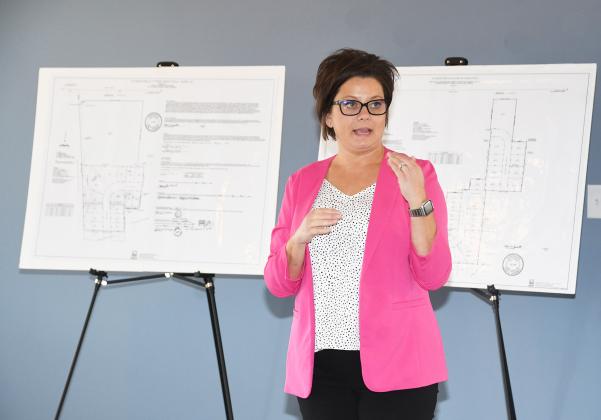One year after receiving state grant, tour features new homes, townhomes and lots
What was a soybean field on the west edge of Aurora exactly one year ago was the site of a housing tour Thursday, where local leaders celebrated success in their efforts to build new single-family homes and townhomes, while also hinting that this may be just the beginning of a much-needed housing surge.
One year after hosting an event where Gov. Pete Ricketts congratulated the community for being awarded a $1 million Rural Workforce Housing Grant, the Aurora Housing Development Corporation offered tours of new homes and townhomes now available for sale in the Streeter Subdivision west of 1st Street. That $1 million grant was matched with $750,000 in local donations and $250,000 in state funding, creating a $2 million revolving loan fund which is already starting to pay dividends.
“We were able to leverage this $2 million into 60 lots and 19 homes that are under construction,” said Jannelle Seim, AHDC president. “We partnered with ADC (Aurora Development Corporation) and Kelsey Bergen, Streeter (Foundation), which is where Gary Warren comes in, Cliff Mesner and Brock Henderson as builders and then the city was also a big part of why we could actually build out more because they were willing to take on this project with us so that we could build out this entire street and take advantage of the monetary risk. I’m proud of the houses that have been built and think that’s amazing, but I think I’m more proud of the relationships that we built during this time so we can do it again.”
A total of 60 lots are platted for housing construction in the Streeter Subdivision, though Seim noted that the grant funds are benefitting other parts of the county as well, by design.
“We partnered with Hampton Housing Solutions and they have a three-bedroom, two-bath home for sale there,” she said. “We also partnered with Jeff Reed on the Phillips project that was already underway and we’re financing a home there, so we were able to really leverage this $2 million.”
Seim reported that AHDC also partnered with Mesner on a tax credit program that will bring in 18 senior living apartments, addressing what the group believes is a critical piece of the community’s housing needs.
“So that’s 44 units we’ve been able to get started in the last 12 months,” Seim said. “We have several donors here and I can’t thank you enough for trusting us with your money, so thank you for that.”
Standing in one of the recently-completed townhomes on Cottage Park Drive, Mesner invited guests to walk through the units, noting that each one has a slightly different color scheme, with half featuring carpeted floors and half vinyl flooring.
“We’ve really enjoyed being over here,” Mesner said. “We’ve had great success with these units and I think you’ll have great success with them here. What you are going to find with these particular units is that most go to seniors and most of those seniors are going to sell a three-bedroom home in order to come here and then those three-bedroom homes will be filled with a family.
“Frankly, you’ll see the same thing with the tax credit program that we do,” Mesner continued. “We started tracking a while back and found that 60 to 70 percent of the people who go into our affordable housing sell a three-bedroom home and most are seniors who just want to get away from the lawn and the snow and all that responsibility. So, I think you are going to see a bunch of single-family homes open up.” (See related story on Mesner’s housing trends presentation)
City, state reaction
Aurora Mayor Marlin Seeman spoke to the small group gathered for Thursday’s by-invitation tour, saying he too is pleased with progress seen over the past 12 months.
“In a housing development timeframe, this is an extraordinarily efficient arc of getting there,” he said. “We’ve taken bare dirt and converted it into lots and houses are the by-products. I want to thank Kelsey, Gary, a whole bunch of donors and the State of Nebraska for getting us here. I’m just proud that the city is able to be a part of that process. We want to build more streets, so let’s keep the project rocking and rolling and do the next best thing.”
Morgan Pearson, a central Nebraska housing representative with the Nebraska Department of Economic Development, toured some of the completed housing units as well Thursday, concluding that what Aurora is doing with the grant funds is exactly what the state wants to see.
“They broke ground a year ago and here we are standing in houses ready to be sold, ready for families to move in,” Pearson said. “This is exactly what we want to see, this quick turn-around. We want to see communities investing in themselves. We want to give them the opportunity to develop the houses that they need and that they know how to build.”
Pearson emphasized that point, explaining that the Rural Workforce Housing program is designed to allow local communities to identify and address their own housing needs.
“This programs really allows them the opportunity to build the houses that their community needs,” she said. “This is a great spotlight that other communities can model their plan after. They took a bean field and now we have families living here, with some older residents moving in or newer families moving in and that’s exactly what we want to see.”
Pearson announced that the $10 million distributed through the first round of Rural Workforce Housing grants has been expanded to $30 million in the next round, which is now available for applications. Unlike the first grant program, which included a 1-to-1 match, the next round offers a 2-to-1 match, meaning that if a community applies for and receives $500,000, the state will match it with $1 million.
“So right now we are in the next round of workforce housing,” she explained. “Some of that money did come from the federal government in the form of COVID relief and there are other funds available under ARPA, which is the American Rescue Plan. There are a lot of great opportunities for developers looking to develop houses.”
Pearson noted that more information, including application guidelines, is available at opportunity.nebraska.gov.
Mesner concluded the brief presentation by reporting that his company is involved with similar housing development projects in several communities, adding that a 2-to-1 match grant is a rare opportunity.
“I’ve been doing this sales pitch for so many communities because the $30 million sitting in Lincoln doesn’t do the state any good at all,” he said. “We need new houses spread all across the state and that is what the state wants. You’re not tied to some sort of income restriction with this, and having a federal or state program that comes without strings attached is extraordinarily rare.”





